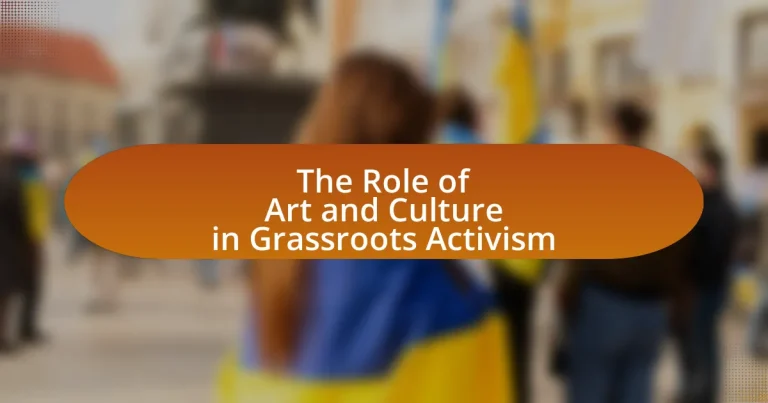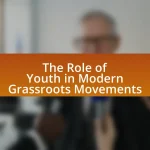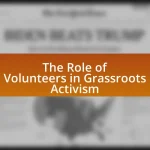The article examines the significant role of art and culture in grassroots activism, highlighting how these elements serve as tools for communication, mobilization, and community building. It discusses the influence of artistic expressions—such as visual art, music, and performance—on shaping narratives and fostering community identity, as well as their historical impact on movements like the Civil Rights Movement. Key elements of art in activism, including expression, community engagement, and social commentary, are explored, along with the challenges activists face in utilizing these forms. The article also emphasizes the importance of cultural narratives in shaping activist strategies and the long-term benefits of integrating art and culture into grassroots movements.
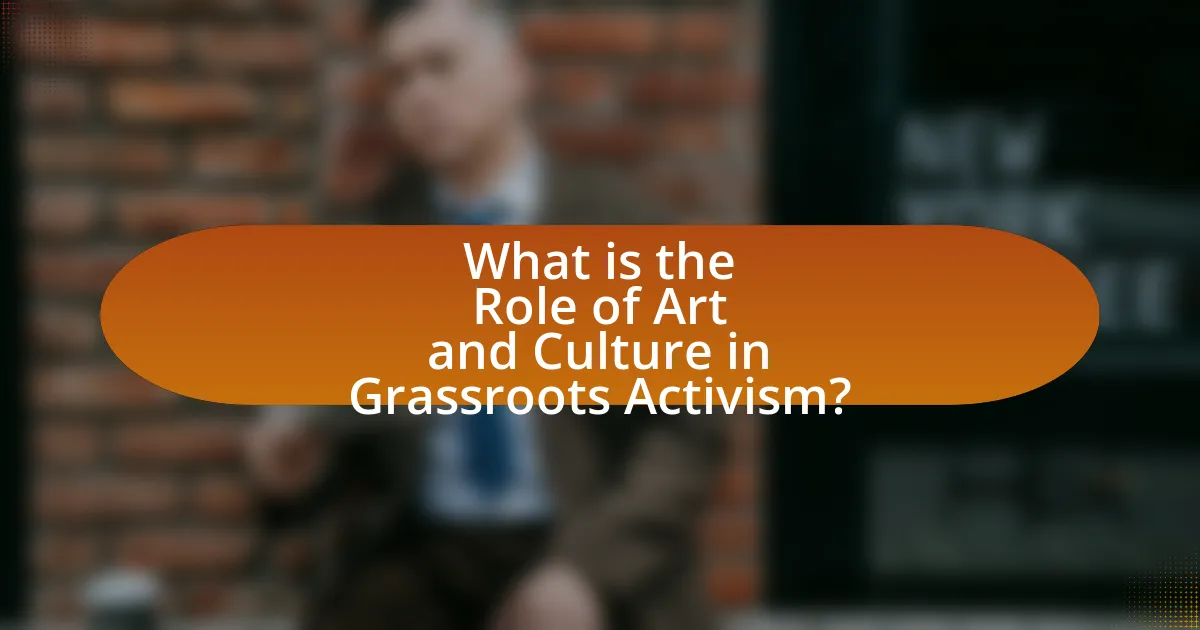
What is the Role of Art and Culture in Grassroots Activism?
Art and culture play a crucial role in grassroots activism by serving as powerful tools for communication, mobilization, and community building. They enable activists to express their messages creatively, making complex social issues more relatable and engaging to a broader audience. For instance, visual art, music, and performance can evoke emotional responses that inspire action and solidarity among community members. Historical examples include the use of protest songs during the Civil Rights Movement, which galvanized support and raised awareness about racial injustice. Additionally, cultural events and art installations can create safe spaces for dialogue, fostering a sense of belonging and collective identity among activists. This integration of art and culture not only enhances the visibility of grassroots movements but also strengthens their impact by resonating with diverse audiences.
How do art and culture influence grassroots movements?
Art and culture significantly influence grassroots movements by shaping narratives, fostering community identity, and mobilizing support. Artistic expressions, such as music, visual art, and performance, serve as powerful tools for communication, allowing movements to convey their messages in relatable and impactful ways. For instance, the Civil Rights Movement in the United States utilized music and visual art to inspire solidarity and raise awareness, exemplified by songs like “We Shall Overcome” and the artwork of artists like Jacob Lawrence. Furthermore, cultural events and festivals can create a sense of belonging and shared purpose among participants, enhancing collective action. Research indicates that cultural engagement can increase civic participation, as seen in studies by the National Endowment for the Arts, which highlight the correlation between arts involvement and community activism. Thus, art and culture not only enrich grassroots movements but also serve as catalysts for social change.
What are the key elements of art and culture in activism?
The key elements of art and culture in activism include expression, community engagement, and social commentary. Expression through various art forms, such as visual arts, music, and performance, allows activists to convey messages and evoke emotions that resonate with audiences. Community engagement is fostered through collaborative projects that unite individuals around shared causes, enhancing solidarity and collective action. Social commentary is embedded in artistic works, providing critical reflections on societal issues and challenging the status quo. Historical examples, such as the use of protest songs during the Civil Rights Movement, illustrate how art can mobilize communities and inspire change.
How do these elements foster community engagement?
Art and culture foster community engagement by creating shared experiences that unite individuals around common values and goals. These elements serve as platforms for expression, allowing community members to voice their concerns and aspirations through various forms of artistic expression, such as murals, performances, and music. For instance, community art projects have been shown to increase participation in local initiatives, as evidenced by the “Art in the Public Realm” study, which found that neighborhoods with public art installations reported a 30% increase in community involvement. This engagement is further enhanced by the ability of art to provoke dialogue and inspire action, making it a powerful tool for grassroots activism.
Why is art considered a powerful tool in activism?
Art is considered a powerful tool in activism because it effectively communicates complex social issues and evokes emotional responses that can inspire action. Through visual imagery, music, and performance, art transcends language barriers and engages diverse audiences, making it accessible and relatable. Historical examples, such as the use of protest songs during the Civil Rights Movement and the impactful imagery of street art in contemporary social movements, demonstrate how art can mobilize communities and raise awareness. Additionally, studies show that art can foster empathy and solidarity, reinforcing collective identities among activists, which enhances the overall impact of grassroots movements.
What historical examples illustrate this power?
Historical examples that illustrate the power of art and culture in grassroots activism include the use of music during the Civil Rights Movement in the United States, particularly the song “We Shall Overcome,” which became an anthem for social justice and unity. This song galvanized activists and helped to mobilize communities against racial segregation and discrimination. Another example is the mural movement in Mexico during the early 20th century, where artists like Diego Rivera used public murals to convey political messages and promote social change, effectively engaging the public in discussions about class struggle and national identity. These instances demonstrate how art and culture can serve as powerful tools for mobilizing communities and fostering social movements.
How does art convey messages that resonate with audiences?
Art conveys messages that resonate with audiences by utilizing visual, auditory, and performative elements to evoke emotions and provoke thought. This resonance occurs through symbolism, cultural references, and relatable narratives that reflect shared experiences or societal issues. For instance, the use of powerful imagery in protest art can encapsulate complex social injustices, making them accessible and impactful for viewers. Historical examples, such as Picasso’s “Guernica,” illustrate how art can communicate the horrors of war and inspire collective action, demonstrating its effectiveness in grassroots activism.
In what ways does culture shape grassroots activism?
Culture shapes grassroots activism by influencing the values, beliefs, and practices that drive community engagement and mobilization. Cultural narratives and symbols often serve as powerful tools for activists, enabling them to resonate with local populations and foster a sense of identity and belonging. For instance, the Civil Rights Movement in the United States utilized music, art, and literature to convey messages of equality and justice, effectively galvanizing support and participation. Additionally, cultural expressions such as street art and performance can raise awareness about social issues, making them more relatable and urgent to the public. Research indicates that culturally rooted activism can enhance community solidarity and increase the effectiveness of campaigns, as seen in various movements worldwide that leverage local traditions and customs to advocate for change.
How do cultural narratives impact activist strategies?
Cultural narratives significantly shape activist strategies by framing issues, influencing public perception, and mobilizing support. These narratives provide a shared understanding of social injustices, which activists leverage to resonate with diverse audiences. For instance, the civil rights movement utilized the narrative of equality and justice, effectively rallying support across various demographics. Research indicates that narratives can enhance emotional engagement, making campaigns more relatable and compelling, as seen in the use of storytelling in movements like Black Lives Matter. This strategic use of cultural narratives not only amplifies the message but also fosters community solidarity, ultimately driving collective action.
What role does cultural identity play in mobilizing communities?
Cultural identity plays a crucial role in mobilizing communities by fostering a sense of belonging and shared purpose among individuals. This shared identity encourages collective action, as community members are more likely to engage in activism when they feel connected to a common cultural heritage or set of values. For instance, research by the Pew Research Center indicates that cultural narratives and symbols can significantly enhance community solidarity, leading to increased participation in grassroots movements. Furthermore, cultural identity often serves as a rallying point for social justice initiatives, as seen in movements like Black Lives Matter, where cultural expressions and identity politics have galvanized widespread support and activism.
How can art and culture be effectively integrated into activism?
Art and culture can be effectively integrated into activism by using creative expressions to communicate messages, mobilize communities, and inspire action. For instance, visual art, music, and performance can convey complex social issues in an accessible manner, fostering emotional connections that drive engagement. Historical examples include the use of protest songs during the Civil Rights Movement, which galvanized public support and raised awareness about racial injustice. Additionally, art installations in public spaces can provoke dialogue and encourage participation in social movements, as seen in the AIDS Memorial Quilt, which not only memorialized victims but also advocated for awareness and policy change. These methods demonstrate that art and culture serve as powerful tools for activism, enhancing visibility and impact.
What challenges do activists face when using art and culture?
Activists face several challenges when using art and culture, including censorship, misinterpretation, and resource limitations. Censorship can occur when authorities restrict artistic expression that critiques social or political issues, limiting the effectiveness of the message. Misinterpretation arises when audiences do not grasp the intended meaning of the artwork, which can dilute its impact. Additionally, activists often struggle with limited financial and material resources, making it difficult to produce high-quality art or reach wider audiences. These challenges hinder the potential of art and culture to drive social change and mobilize communities effectively.
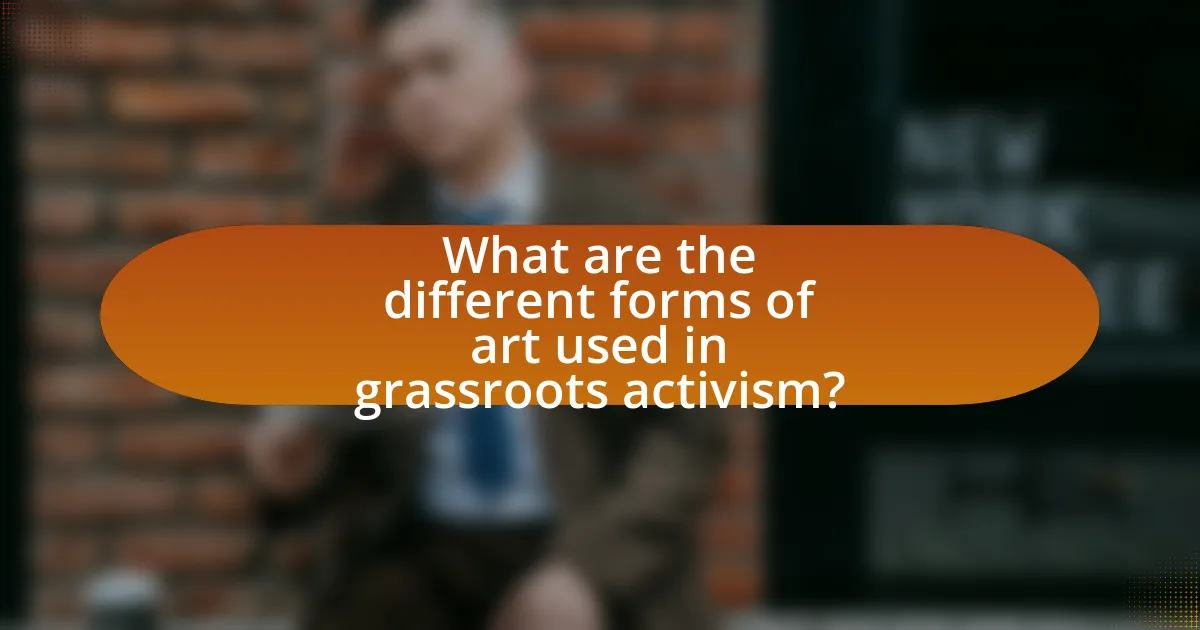
What are the different forms of art used in grassroots activism?
Different forms of art used in grassroots activism include visual art, performance art, music, literature, and digital media. Visual art, such as murals and graffiti, serves to convey messages and provoke thought in public spaces, exemplified by the murals created during the Civil Rights Movement. Performance art engages audiences through live demonstrations, often addressing social issues directly, as seen in the works of groups like the Living Theatre. Music acts as a unifying force, with protest songs historically rallying communities, such as those by Bob Dylan during the anti-war movement. Literature, including poetry and essays, articulates the struggles and aspirations of marginalized groups, as demonstrated by the writings of authors like Audre Lorde. Digital media, including social media campaigns and online videos, amplifies grassroots messages to a broader audience, effectively mobilizing support, as evidenced by movements like Black Lives Matter. Each of these art forms plays a crucial role in expressing dissent, fostering community, and inspiring action within grassroots activism.
How do visual arts contribute to activism?
Visual arts contribute to activism by serving as powerful tools for communication and expression, enabling marginalized voices to be heard. Through mediums such as painting, sculpture, and photography, artists can convey complex social issues and inspire emotional responses, fostering awareness and engagement among the public. For instance, the use of visual imagery in protests, like the iconic “We Can Do It!” poster during World War II, galvanized support for women’s labor rights and has since become a symbol of feminist activism. Additionally, studies have shown that visual arts can enhance community solidarity and mobilization, as seen in the murals of the Chicano civil rights movement, which visually articulated the struggles and aspirations of the community. Thus, visual arts not only document social injustices but also motivate collective action and drive change.
What types of visual art are most effective in conveying activist messages?
Visual art forms such as murals, street art, and photography are most effective in conveying activist messages. Murals and street art often reach a broad audience in public spaces, making complex social issues accessible and engaging. For instance, the “Black Lives Matter” mural in Washington, D.C. became a powerful symbol of the movement, drawing attention to racial injustice. Photography, particularly documentary photography, captures real-life struggles and humanizes issues, as seen in the works of photojournalists like Dorothea Lange during the Great Depression, which galvanized public support for social change. These art forms not only communicate messages visually but also evoke emotional responses, fostering community engagement and activism.
How do murals and street art engage the public?
Murals and street art engage the public by transforming urban spaces into interactive platforms for dialogue and expression. These art forms invite community participation and provoke thought on social issues, often reflecting local culture and history. For instance, studies have shown that murals can increase community pride and cohesion, as seen in neighborhoods where artists collaborate with residents to create works that resonate with their experiences. Additionally, street art often addresses political and social themes, encouraging viewers to reflect on and discuss these topics, thereby fostering a sense of community activism.
What role does performance art play in grassroots movements?
Performance art serves as a powerful tool in grassroots movements by facilitating emotional engagement and raising awareness about social issues. This form of art allows activists to convey complex messages and evoke empathy through visceral experiences, making abstract concepts more tangible. For instance, the performance art piece “The Vagina Monologues” has been instrumental in feminist movements, highlighting issues of violence against women and promoting dialogue around gender equality. Additionally, performance art can mobilize communities, as seen in the “AIDS Memorial Quilt” project, which not only commemorated lives lost to AIDS but also galvanized public action and policy change. Thus, performance art plays a crucial role in grassroots movements by fostering connection, inspiring action, and amplifying marginalized voices.
How can theater and dance be used to raise awareness?
Theater and dance can effectively raise awareness by conveying social issues through storytelling and performance. These art forms engage audiences emotionally, prompting reflection and dialogue about critical topics such as human rights, environmental concerns, and social justice. For instance, the play “The Vagina Monologues” has sparked conversations about women’s rights and violence against women, demonstrating how theater can mobilize public discourse. Similarly, dance pieces like “The Dance of the Dispossessed” highlight the struggles of marginalized communities, fostering empathy and understanding. By utilizing visual and auditory elements, theater and dance create memorable experiences that resonate with audiences, making complex issues more accessible and relatable.
What are some successful examples of performance art in activism?
Successful examples of performance art in activism include the “AIDS Memorial Quilt,” which raised awareness about the AIDS crisis through a large-scale, collaborative art project, and “The Vagina Monologues,” which has been used to address issues of women’s rights and violence against women globally. The AIDS Memorial Quilt, initiated in 1987, consists of thousands of individual panels commemorating those lost to AIDS, effectively humanizing the epidemic and mobilizing public support for research and treatment. “The Vagina Monologues,” created by Eve Ensler, has been performed worldwide to highlight women’s experiences and has inspired the global “V-Day” movement, which seeks to end violence against women. Both examples demonstrate how performance art can effectively engage audiences, provoke thought, and inspire action in social justice movements.
How does digital art and social media impact grassroots activism?
Digital art and social media significantly enhance grassroots activism by increasing visibility and engagement for social causes. Digital art serves as a powerful tool for storytelling, allowing activists to convey complex messages visually, which can resonate more deeply with audiences. Social media platforms amplify these messages, enabling rapid dissemination and fostering community building among supporters. For instance, the viral spread of the “Black Lives Matter” movement on platforms like Instagram and Twitter illustrates how digital art and social media can mobilize large groups, raise awareness, and influence public opinion. Research by the Pew Research Center indicates that 69% of adults in the U.S. use social media, providing a vast audience for grassroots campaigns. This combination of digital art and social media not only democratizes the creation and sharing of activist content but also empowers marginalized voices, making activism more inclusive and impactful.
What platforms are most effective for sharing activist art?
Social media platforms, particularly Instagram, Facebook, and Twitter, are the most effective for sharing activist art. These platforms allow artists to reach a wide audience quickly, facilitating engagement and interaction. For instance, Instagram’s visual-centric design is ideal for showcasing artwork, while Facebook groups can foster community discussions around specific causes. Additionally, Twitter’s real-time nature enables rapid dissemination of art related to current events, amplifying messages and mobilizing support. According to a 2021 study by the Pew Research Center, 69% of adults in the U.S. use Facebook, making it a powerful tool for grassroots activism and art sharing.
How does online art mobilize support for grassroots causes?
Online art mobilizes support for grassroots causes by creating visual narratives that resonate emotionally with audiences, fostering community engagement and awareness. Platforms like social media allow artists to share their work widely, reaching diverse audiences and amplifying messages related to social justice, environmental issues, and human rights. For instance, campaigns such as “Art for Black Lives” have successfully utilized online art to raise funds and awareness for racial justice initiatives, demonstrating the power of art in galvanizing public support and action.
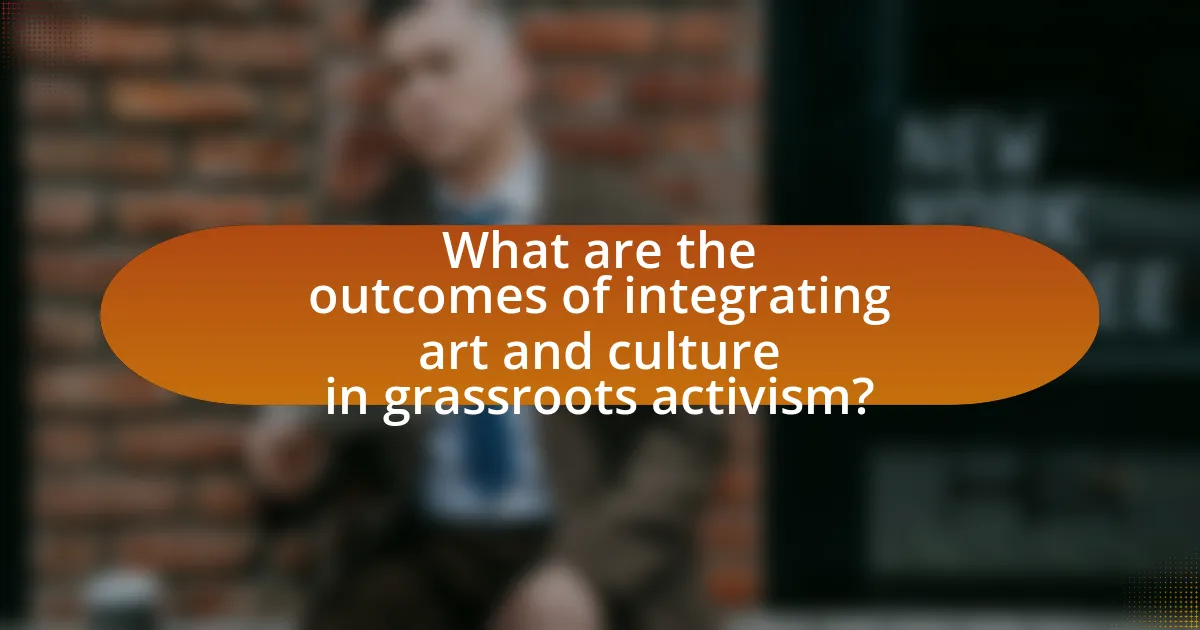
What are the outcomes of integrating art and culture in grassroots activism?
Integrating art and culture in grassroots activism leads to enhanced community engagement and increased visibility for social issues. This integration fosters emotional connections, making complex issues more relatable and accessible to a broader audience. For instance, public art installations and performances can effectively communicate messages about social justice, as seen in the “Art Against Apartheid” movement, which utilized art to raise awareness and mobilize support against racial segregation in South Africa. Additionally, studies indicate that culturally infused activism can result in higher participation rates, as art often attracts diverse demographics, thereby amplifying voices that might otherwise be marginalized.
How does art enhance the visibility of grassroots movements?
Art enhances the visibility of grassroots movements by providing a powerful medium for expression that resonates emotionally with audiences. Through visual art, music, performance, and literature, grassroots movements can communicate their messages more effectively, capturing public attention and fostering empathy. For instance, the use of murals in urban areas has historically drawn attention to social issues, as seen in the civil rights movement where artists like Charles White depicted struggles for equality, making the movement’s goals more relatable and urgent to the public. Additionally, art can transcend language barriers, allowing diverse communities to engage with the movement’s message. This ability to evoke emotional responses and create a shared sense of identity significantly amplifies the reach and impact of grassroots activism.
What metrics can be used to measure this visibility?
Metrics that can be used to measure visibility in grassroots activism include social media engagement, attendance at events, media coverage, and community outreach effectiveness. Social media engagement can be quantified through likes, shares, comments, and follower growth, indicating the reach and impact of campaigns. Attendance at events provides a direct measure of community involvement and interest, while media coverage can be assessed through the number of articles, mentions, and the sentiment of coverage in local and national outlets. Community outreach effectiveness can be evaluated through surveys and feedback mechanisms that gauge public awareness and perception of the activism efforts. These metrics collectively provide a comprehensive view of visibility and influence within grassroots movements.
How does increased visibility affect public perception?
Increased visibility positively affects public perception by enhancing awareness and understanding of social issues. When grassroots activism gains visibility through art and culture, it captures public attention, leading to greater engagement and support. For instance, campaigns that utilize visual art or performance can evoke emotional responses, making complex issues more relatable and fostering empathy among the audience. Research indicates that visibility can lead to increased public discourse, as seen in movements like Black Lives Matter, where art played a crucial role in shaping narratives and mobilizing communities. This correlation between visibility and public perception underscores the importance of strategic communication in activism.
What impact does cultural expression have on community resilience?
Cultural expression significantly enhances community resilience by fostering social cohesion and a shared identity among members. This collective identity strengthens bonds, enabling communities to better withstand and recover from adversities such as economic downturns or natural disasters. For instance, research by the National Endowment for the Arts indicates that communities with active cultural programs report higher levels of civic engagement and social trust, which are crucial for resilience. Additionally, cultural expression provides a platform for dialogue and healing, allowing communities to process trauma collectively, as seen in post-conflict societies where art initiatives have facilitated reconciliation and rebuilding efforts.
How does cultural engagement strengthen community bonds?
Cultural engagement strengthens community bonds by fostering shared identities and collective experiences among individuals. When community members participate in cultural activities, such as festivals, art exhibitions, or performances, they create a sense of belonging and mutual understanding. Research indicates that communities with active cultural engagement report higher levels of social cohesion and trust. For instance, a study by the National Endowment for the Arts found that participation in arts and culture can lead to increased civic engagement and stronger interpersonal relationships, demonstrating that cultural activities serve as a catalyst for building connections and enhancing community solidarity.
What are the long-term benefits of cultural activism?
Cultural activism yields long-term benefits such as enhanced community cohesion, increased awareness of social issues, and the promotion of cultural diversity. These benefits manifest as cultural activism fosters a sense of belonging and shared identity among community members, which can lead to sustained collaboration and support for social causes. For instance, studies have shown that communities engaged in cultural activism experience lower rates of social isolation and higher levels of civic participation. Additionally, cultural activism raises awareness about critical social issues, influencing public discourse and policy changes over time. This is evidenced by movements like the Civil Rights Movement in the United States, where art and culture played pivotal roles in shaping public opinion and legislative reforms. Furthermore, cultural activism promotes cultural diversity by encouraging the expression of various identities and perspectives, which enriches societal understanding and tolerance.
What best practices can activists adopt when using art and culture?
Activists can adopt several best practices when using art and culture to enhance their message and engagement. First, they should ensure that their art is culturally relevant and resonates with the target audience, as this increases emotional connection and impact. For instance, using local artists and culturally significant symbols can foster a sense of community ownership and pride, which has been shown to enhance participation in movements, as seen in the success of the “Art for Social Change” initiatives.
Second, activists should prioritize collaboration with artists from diverse backgrounds to create inclusive narratives that reflect the multifaceted nature of social issues. Research indicates that diverse perspectives in artistic expression can lead to more comprehensive understanding and empathy among audiences, as highlighted in the “Cultural Activism and Social Change” study by the University of California.
Third, utilizing various mediums—such as visual arts, performance, and digital platforms—can broaden outreach and engagement. For example, the use of social media to share art has proven effective in mobilizing support, as evidenced by the viral success of campaigns like “Black Lives Matter,” which leveraged art to communicate powerful messages.
Lastly, activists should measure the impact of their artistic initiatives through feedback and community engagement to refine their approaches continually. This practice not only enhances the effectiveness of their campaigns but also builds trust and accountability within the community, as demonstrated by the participatory art projects documented in “The Role of Art in Community Development” by the National Endowment for the Arts.
How can activists ensure inclusivity in their artistic expressions?
Activists can ensure inclusivity in their artistic expressions by actively engaging diverse communities in the creative process. This approach allows for a variety of perspectives and experiences to be represented, fostering a sense of belonging and ownership among participants. For instance, initiatives like community art projects or collaborative workshops have been shown to amplify marginalized voices, as evidenced by the success of programs such as the “Art for Social Change” initiative, which emphasizes participatory art-making. By prioritizing collaboration and representation, activists can create artworks that resonate with a broader audience and reflect the complexities of social issues.
What strategies can enhance collaboration between artists and activists?
Enhancing collaboration between artists and activists can be achieved through the establishment of interdisciplinary projects that integrate artistic expression with social justice initiatives. These projects can create a platform for dialogue, allowing artists to use their creative skills to amplify activist messages, while activists can provide context and urgency to the artists’ work.
For instance, community art projects that address local issues, such as murals or performances, can engage the public and raise awareness about specific causes. Research shows that participatory art initiatives can foster community engagement and mobilize support for social movements, as evidenced by the success of the “Art for Social Change” program, which demonstrated increased community involvement in activism through artistic collaboration.
Additionally, creating networks that connect artists and activists can facilitate resource sharing, skill development, and mutual support, leading to more impactful campaigns. By leveraging social media platforms, both groups can reach wider audiences, further enhancing their collaborative efforts.
